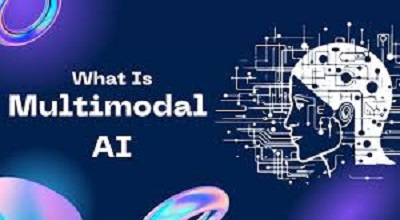Multimodal AI
Multimodal AI: AI has advanced quickly, going from single-modal systems (such as text-only chatbots) to multimodal AI, which combines text, graphics, video, and voice to provide comprehension that is more akin to that of a person. This development is transforming a variety of industries, including healthcare and entertainment, by allowing machines to easily comprehend and produce content from a variety of data formats.
We examine state-of-the-art AI advancements at ZoomDoors.com, and in this extensive guide, we’ll delve deeply into multimodal AI, covering its most recent advancements, uses, difficulties, and prospects.
Multimodal AI: What is it?
Artificial intelligence systems that simultaneously process and understand many data inputs, including text, images, audio, and video, are referred to as multimodal AI. Multimodal AI integrates numerous inputs to improve comprehension, reasoning, and decision-making, in contrast to standard AI models that only handle one sort of data.
What Makes Multimodal AI Vital?
- Impersonations Human Perception: Information from many senses (sight, sound, and touch) is naturally processed by humans. This capability is replicated by multimodal AI.
- Improved Contextual Understanding: Accuracy is increased when text is combined with images or sound (e.g., identifying sarcasm in a movie).
- Improved User Experience: Underpins cutting-edge applications such as medical diagnostics, driverless cars, and virtual assistants.
How Is Multimodal AI Operational?
Multimodal AI systems adhere to a methodical process:
A. Input and Fusion of Data
- Early Fusion: Merges unprocessed data (e.g., aligning photos and text captions before processing).
- Late Fusion: Combines results at the decision stage after processing each modality independently.
- Hybrid Fusion: For best results, combine early and late fusion.
B. Extraction of Features
- For photos and videos, Convolutional Neural Networks (CNNs) are used.
- Text transformers (such as GPT-4 and BERT).
- For audio, use WaveNet or Recurrent Neural Networks (RNNs).
C. Multimodal Education
teaches models to discover connections between various kinds of data (e.g., connecting lip movements in films with spoken phrases).
The Most Recent Developments in Multimodal AI
A. GPT-4 Vision from OpenAI (GPT-4V)
- Capable of analyzing both text and graphics (e.g., describing memes, solving visual puzzles).
- utilized in visually impaired accessibility technologies.
B. Gemini from Google
- a native multimodal paradigm that does not require format conversion while processing text, pictures, and audio.
- In certain multimodal reasoning tasks, it performs better than humans.
C. ImageBind by Meta
- connects six modalities: motion, depth, temperature, audio, image, and text data.
- allows AI to produce content using a variety of sensory inputs.
D. Kosmos-1 from Microsoft
- A multimodal large language model (MLLM) that can comprehend images, text, and other types of data.
- capable of carrying out tasks such as visual question answering (VQA).
Multimodal AI Applications
A. Medical Care
- Diagnostics: Examines MRIs, X-rays, and medical records to accurately identify diseases.
- Surgical Assistance: Integrates AI-guided accuracy with real-time video.
B. Self-Driving Automobiles
- enables safer navigation by processing LiDAR, cameras, and audio sensors.
C. Media & Entertainment
- Deepfake Detection: Uses audio-visual irregularities to detect altered videos.
- Customized Content: Makes movie recommendations based on face expressions.
D. Customer Service
AI chatbots that can interpret facial expressions and voice tones to determine emotions.
E. Instruction
Interactive Learning: AI instructors use voice, text, and illustrations to convey ideas.
Obstacles and Restrictions
- Data Complexity: Needs large, multimodal, labeled datasets.
- Computational Costs: GPT-4V training requires a lot of GPU power.
- Ethics & Bias: Potential for prejudices to be amplified across mediums.
Multimodal AI’s Future
- Instant voice-to-sign language translation is known as real-time multimodal translation.
- Emotionally Intelligent AI: Recognizes human emotions through text, voice, and facial expressions.
- Brain-Computer Interfaces (BCIs): Use neural signals to communicate directly with AI.
In conclusion
By combining text, graphics, video, and music to create previously unheard-of capabilities, multimodal AI is revolutionizing how machines interact with the outside world. Anticipate advances in robots, more intelligent virtual assistants, and incredibly lifelike AI-generated entertainment as research continues.

